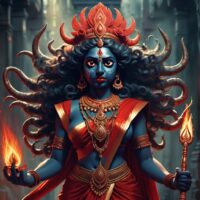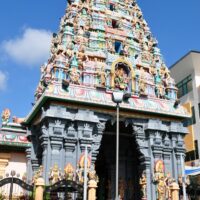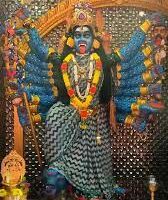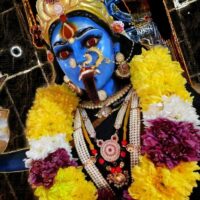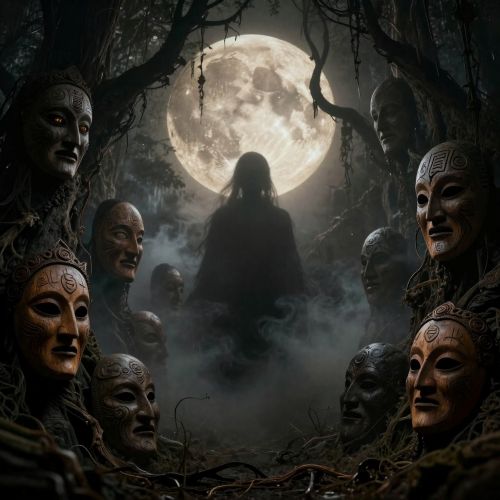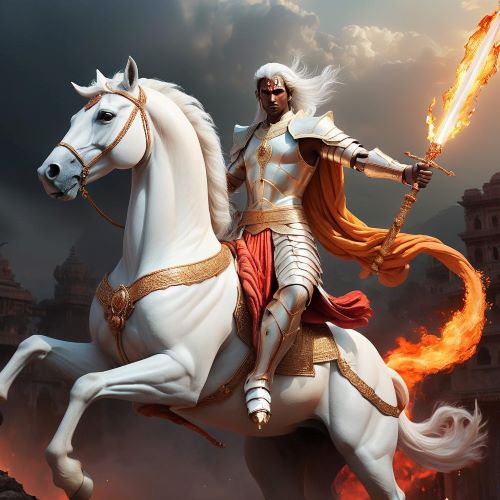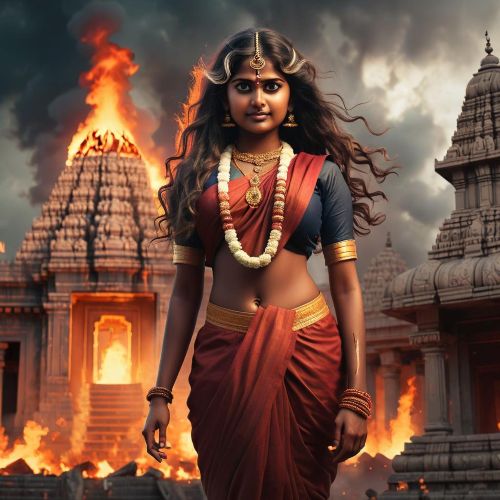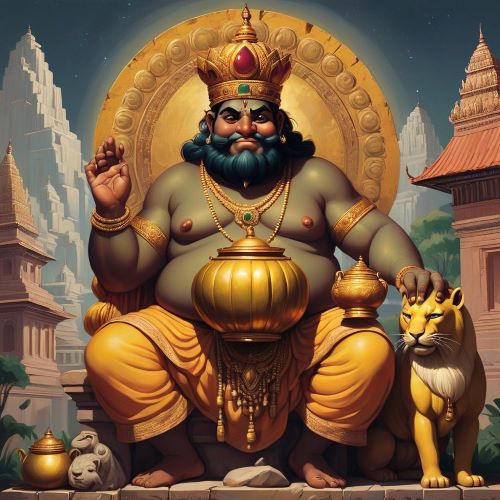Kaliamman : The Village Guardian
Listen
At a glance
| Description | |
|---|---|
| Origin | Indian Mythology |
| Classification | Gods |
| Family Members | N/A |
| Region | India |
| Associated With | Protection |
Kaliamman
Introduction
Kaliamman, a powerful village deity in Tamil Nadu, is venerated as a fierce guardian and compassionate protector. Rooted deeply in Dravidian folk traditions, she embodies the balance between wrath and benevolence. Unlike the pan-Indian form of Kali, Kaliamman is closely linked to the rural spiritual landscape, often regarded as the mother who shields communities from harm. She is worshipped fervently in local shrines, where rituals and festivals draw thousands of devotees seeking healing, justice, and protection. Her role is both divine and intimate—an omnipotent force who also serves as the nurturing mother of the village.
Physical Traits
Kaliamman’s visual depiction is striking, capturing her role as both a destroyer of evil and a source of divine power. She is typically portrayed with dark blue or black skin, symbolizing eternity and the dissolution of illusion. Her fearsome appearance includes bulging eyes and sharp teeth, evoking her readiness to battle demonic forces.
Multiple arms extend from her form, each wielding powerful symbols—such as a trident, a sickle, or a bell—each representing tools to cut through ignorance and ward off evil. Her tongue, dramatically extended, is a prominent feature, signifying her moment of realization when she steps on Lord Shiva, representing the calming of uncontrollable rage.
Kaliamman is often seen adorned with a garland of skulls, standing over a defeated demon or in a dance-like posture amidst flames. Her presence radiates both menace and sanctity, reminding devotees of her protective power when properly revered and her destructive capability when provoked.
Family
In the pantheon of South Indian goddesses, Kaliamman is a fierce yet maternal manifestation of Parvati, who transforms into this form to defeat evil when divine justice is required. This connection to Parvati links her directly to Lord Shiva, reinforcing the cosmic balance between destruction and regeneration.
Kaliamman’s mythological emergence stems from urgent cosmic needs—when existing deities could not quell rising evil, her fierce incarnation materialized as the ultimate force of righteousness. Though her consort is never the central focus in her temples, her association with Shiva is implied through stories where his calming presence tames her wrath.
In village mythology, Kaliamman is considered the spiritual mother of the local population. Families and clans often claim ancestral ties with her, emphasizing her role as a personal and familial guardian rather than just a celestial entity.
Other names
Kaliamman is known by several names that reflect her many forms and attributes across regions. In some areas, she is worshipped as Karumariamman, particularly associated with health and fertility, indicating her role as a healer. Another common name is Veerakali, emphasizing her valor and battlefield prowess.
At the famed Thillai Kali Amman Temple in Chidambaram, she is venerated as Thillai Kali, revered for both her fierce strength and scholarly association, a unique trait not always present in other forms. The name Bhadrakaliamman highlights her as a beneficent protector, blending auspiciousness with might.
Each name underlines a different facet—be it her warrior spirit, healing abilities, or maternal nature—demonstrating her adaptability and importance in the religious lives of countless communities.
Powers and Abilities
Kaliamman’s divine powers are both formidable and nurturing, making her one of the most relied-upon deities in South Indian village traditions. She is considered the first line of defense against spiritual and physical threats. Her ability to cleanse a space of dark energies is particularly valued during times of epidemic or misfortune.
She is believed to have command over disease, rain, fertility, and justice. Devotees seek her blessings to recover from ailments, drive away malevolent spirits, and bring peace to disturbed households. Unlike more passive deities, Kaliamman responds to intense rituals—her power is invoked through drumming, fire-walking, and trances.
In many temples, her worship involves rites that directly engage her presence—these may include symbolic blood offerings or fire rituals aimed at purifying communities. Her energy is not just spiritual; it manifests in concrete results, according to believers, protecting crops, families, and even entire villages from calamity.
Modern Day Influence
In modern Tamil Nadu, Kaliamman continues to be a central figure in village life and urban worship alike. Her shrines—often simple yet spiritually vibrant—serve as hubs for communal unity. Annual festivals, known as Amman Thiruvizhas, feature dramatic rituals such as walking on fire, dancing in trance, and elaborate processions that fill the streets with music and color.
Her significance extends into contemporary media. In Tamil cinema and television, she is portrayed as a righteous force confronting injustice, reinforcing moral values and divine intervention. Many women, in particular, find empowerment in her fierce form, seeing in her a reflection of their own struggles and resilience.
Diaspora communities in countries like Sri Lanka, Malaysia, and Singapore have carried Kaliamman’s worship abroad, where new temples and festivals continue to thrive. Despite modernization, her rituals remain authentic, blending ancient traditions with evolving cultural contexts. Kaliamman also inspires contemporary interpretations in art and literature. Her dual identity as fierce and nurturing has made her a subject of feminist theology and spiritual discourse, presenting her as a model for strength in the face of adversity.
Related Images
Source
Narayan, K. (2023). The Many Faces of Amman: A Study of South Indian Mother Goddesses. Retrieved from https://www.southindianreligion.com/amman
Tamil Culture Hub. (2021). Kaliamman: The Fierce Mother Goddess of Tamil Nadu. Retrieved from https://www.tamilculturehub.com/kaliamman-goddess
Hinduism Today. (2019). Kaliamman and the Protection of Communities. Retrieved from https://www.hinduismtoday.com/kaliamman-protector
Zvelebil, K. V. (1992). Tamil Traditions on Subrahmanya-Murugan. Institute of Asian Studies.
Anand, M. (2015). Folk Deities of South India: Rituals, Myths, and Communities. Oxford University Press.
Srinivasan, R. (2003). Goddess Cults of Tamil Nadu: Tradition and Transformation. Navayana Publications.
Frequently Asked Questions
What is lorem Ipsum?
I am text block. Click edit button to change this text. Lorem ipsum dolor sit amet, consectetur adipiscing elit. Ut elit tellus, luctus nec ullamcorper mattis, pulvinar dapibus leo.
What is lorem Ipsum?
I am text block. Click edit button to change this text. Lorem ipsum dolor sit amet, consectetur adipiscing elit. Ut elit tellus, luctus nec ullamcorper mattis, pulvinar dapibus leo.
What is lorem Ipsum?
I am text block. Click edit button to change this text. Lorem ipsum dolor sit amet, consectetur adipiscing elit. Ut elit tellus, luctus nec ullamcorper mattis, pulvinar dapibus leo.
What is lorem Ipsum?
I am text block. Click edit button to change this text. Lorem ipsum dolor sit amet, consectetur adipiscing elit. Ut elit tellus, luctus nec ullamcorper mattis, pulvinar dapibus leo.
What is lorem Ipsum?
I am text block. Click edit button to change this text. Lorem ipsum dolor sit amet, consectetur adipiscing elit. Ut elit tellus, luctus nec ullamcorper mattis, pulvinar dapibus leo.


